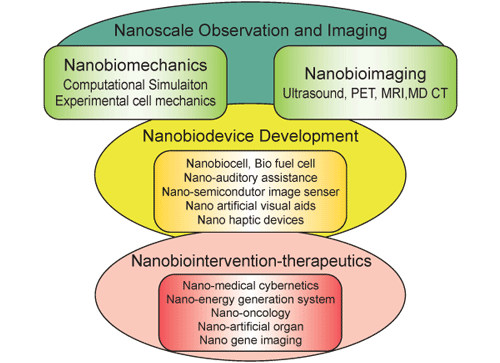HOME > Program Outline > Research Targets
Research Targets
Detailed prospective research activities are now described, again focusing on four major target areas.

i) Nano-biomechanics
Experimental. Prof. M. Sato and his group will further study the mechanics of living cells, including vascular endothelial cells and smooth muscle cells. Particular interest and stress will be placed on the nanoscale mechanics of the subcellular organisation from a viewpoint of directly manipulating cellular functions to develop cellular nano-medicine.
Prof. H. Wada and his group focus on the inner hair cells of the auditory system, particularly prestin, the motor protein, using sophisticated molecular biological and nano-mechanical approaches, with AFM and other advanced methods developed in their laboratory.
Computational. Prof. T. Yamaguchi and his group will continue to pursue the nano- to microscale biomechanical simulation of blood cells, including red blood cells (RBCs) and platelets. They are also interested in white blood cells in an analogy to self-propelling micro-organisms. The analysis will be combined with the novel measurement technique of confocal microparticle image velocimetry (confocal micro PIV). This is a unique method and the computed results will be compared with real measurements for validation and to model the behaviour of blood cells under various circumstances.
Prof. T. Hayase and his group focus on white blood cells in the microcirculation of the body and lung. They will also combine computations and experiments to clarify and develop a method to manipulate the microcirculation.
ii) Nano-bioimaging
Ultrasonography. Prof. H. Kanai and his group have developed a sophisticated method of tissue characterisation using nanoscale wave propagation within tissues of the heart and vessels. They will extend it to the measurements of physical properties in living tissues; the results will be provided to the computational biomechanics group to evaluate the crossover interference of blood flow and mechanical interactions of solid structures. This will lead to further understanding of the pathogenesis of atherosclerosis-related diseases.
Prof. S. Umemura and his group will develop a method to selectively destroy nano-microcapsules using ultrasound. This is a key study for the drug delivery system (DDS). The ultrasound bubble manipulation method will have a variety
Radiographic methods. The clinical application of positron emission tomography (PET) was first established at Tohoku University.
Prof. M. Tashiro, replacing Prof. M. Itoh who is one of the inventors of PET and its application to functional molecular imaging, pursuing further developments of PET imaging medicine and technology.
Prof. S. Takahashi is an expert in CT and MRI technology. He and his group will develop radiological methods to apply nano-medicine to human patients.
Prof. H. Fukuda is another inventor of PET and is currently performing MRI studies of normal and aged human brains. He also combines these techniques in multimodal nano-micro-macroscale invasive and noninvasive methods.
iii) Nano-biodevices
Nano-level micro-devices, based on quantum-level electronics and nano-fabrication, will be integrated with nano-micro-level electrochemical devices to implement nano-micro-level prosthetics and novel functional scaffolds in the body.
Prof. Nishizawa is an internationally recognised electrochemist who is applying electrochemical methods to arrange cultured cells and develop biofuel cells as possible power sources for in vivo nano-micro devices.
Prof. T. Tanaka is an expert in MEMS electronics devices
Prof. T. Yoshinobu is conducting research on novel chemical image sensors to be applied to the visualisation of cellular and subcellular nano-imaging and manipulation.
Prof. M. Tanaka is developing sensing aids of the skin.
Prof. Kawase is developing and applying nano-micro-level auditory support devices from the perspective of clinical medicine.
iv) Nano-biointervention
The fundamental engineering studies will not be complete unless they are actually applied to the human body; that is, they must be clinically tested. Thus, we have included active clinicians and clinical investigators in the project.
Prof. M. Yoshizawa and Prof. H. Matsuki from the engineering school and Prof. T. Yambe are long-standing team members of the Tohoku University artificial heart project and other novel artificial organs based on nano-biomedical engineering.
Prof. N. Ohuchi is a well-known oncology surgeon who works in nano-medicine appliance development.
Prof. N. Chiba is a leading oncologist, investigating molecular aspects of leukemia-related genes.